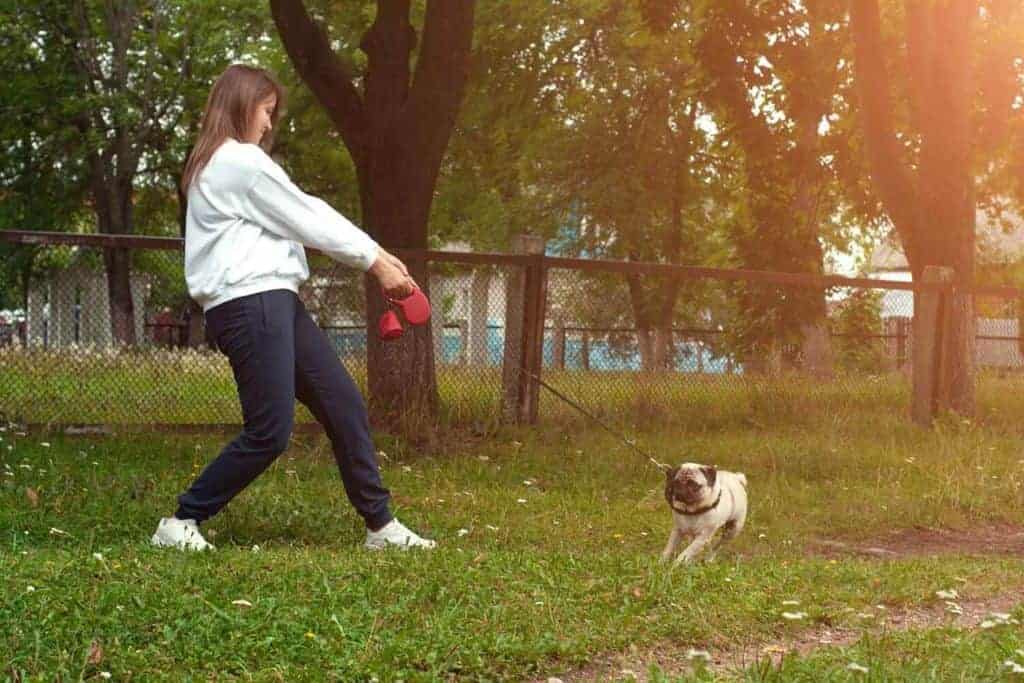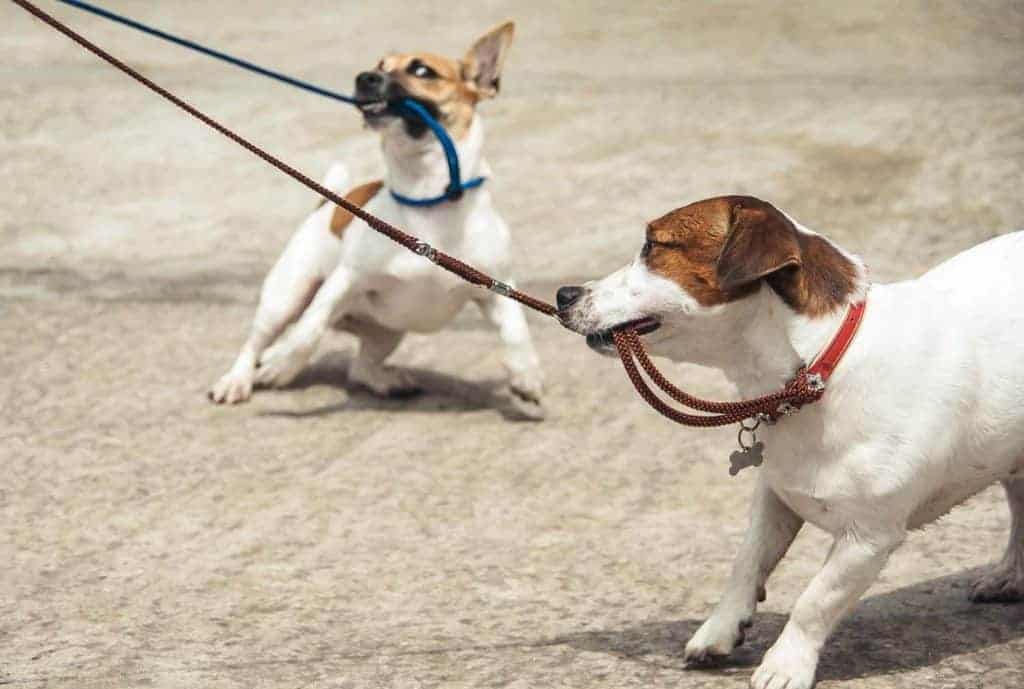
Dogs love walks, right? Sorta, but they don’t always walk well. Struggling with a dog who just flat-out refuses to walk? If so, this is going to be the topic for you!
When working with a dog who suddenly refuses to walk, you have to understand the reason why he won’t walk, and then work on helping him get back to the enjoyable part of walking again. This could involve understanding fears or pain, or it could be addressing your leash and walking/technique. When working with a dog who refuses to walk in general, you should understand what’s going on in his doggy brain and how you can help him enjoy his time out and about again. Here’s your go-to guide on working with a dog who simply won’t walk “properly” on a leash.
Reasons why your dog may refuse to walk
Assuming that your doggo has just suddenly decided that he isn’t going to walk anymore when he was previously fine, you’ll want to get to the bottom of the reason why. Here are some of the most common reasons that walking may not be fun all of a sudden.
They’re in pain or uncomfortable
The main reason for a dog to suddenly dig in his heels and refuse to move forward is because they are in pain. Maybe their collar or harness is pinching, or maybe he’s been bitten by a bug or even another dog and he’s in pain. Perhaps, too, the pavment is too cold or too hot and he prefers to stay on the grass instead.
They’re scared
Dogs, while they may seem brave, quite often can be very fear-led animals. If they refuse to walk onward after otherwise being fine, it could be because they are scared. Maybe there’s an aggressive person or doggo nearby that they don’t want to approach. Maybe there’s a sound that’s painful or scary. Fear is a pretty strong motivator to want to stay put, after all.
They don’t want to leave
You have to admit that this one is kinda adorable, right? Your doggo is having so much fun at the park or sniffing that one particular rock that he just can’t bear to leave. So, he simply refuses! While frustrating, it’s definitely better than the above two options, right?
Should you drag a dog that won’t walk?
No, you should not drag a dog that won’t walk with you. This is mostly because you have to understand that his refusal to walk is a message to you. Don’t just tug on the leash and force him to come with you.
Stop, take a moment to figure out what he’s trying to say to you, and then do what you have to do to help solve his problem (more on that in a bit). Dragging your dog against his will can cause him injury in some cases and it can also do a lot of emotional damage in which he will fear you or, at the least, struggle to understand what you’re asking from him.
The only time that you should ever drag a dog on his leash is if he’s in danger of getting hurt (ie: hit by a car or falling off a ledge, etc) and you don’t have the time to convince him to move on his own.
How to get your dog to walk with you
So, now for the actual art of getting your dog to walk with you. To get to the bottom — and end — of your dog walking problem, here are the steps to follow to make it a concern of the past.
Figure out the problem
First, you’ll want to understand what the problem is. Is his leash hurting him? Is it too cold or hot for his paws on the pavement? Did he get hurt while playing? Is he stressed or scared? Is he just having too much fun and won’t leave? These all require a different approach.
With the pain or discomfort situation, you’ll need to figure out what it’s caused by and then address it. It could be a new leash or a new collar or harness. If it’s discomfort from the temperature, encourage him to walk on the grass or allow him to rest in the shade and then continue in short spurts so that he can save his paws (plus, you’ll want to change your scheduled walking time to keep this from happening again).
If he’s scared or stressed, figure out what the trigger is and then either work on exposing him to it slowly to help him condition his response, or take him on another route so that he can get back to enjoying his walk again. It doesn’t mean that you have to always give him to all fears that he has, but if he’s too scared to walk, don’t force him to do it just because you know the fear to be harmless yourself.
Tempt him with treats
When it comes to any and all of these issues, the first trick is going to be delicious treats! Bring his favorites with you so that you can get his attention right away from having “the good stuff”. This should help get him moving again and you may not have any other problems. If he doesn’t move for treats — especially his favs — it’s a hint that his problem is serious enough that it can’t be solved by treats.
Take it slow
In getting him to walk again after a painful experience or a scary one, you’ll need to always take it slow. There is no particular speed, of course, just make sure that you’re working at your dog’s pace. Watch his body language and match your pace to his so that, if he stops again, you’ll know it and you can encourage him to keep going on again after a few moments.
Make sure he knows what he’s supposed to do
It seems obvious, but sometimes dogs may not understand what you’re asking them to do. Why do you want him to move forward after he’s been sitting under a tree with you? Why are we suddenly going right when he wants to go left where the good smells are? If he doesn’t know what you’re asking, you’ll need to teach this to him. More on that later!
Be kind rather than firm
No matter how hot or cold it is, or how embarrassed or frustrated you’re with his refusal to walk, make sure that you are always kind. Keep your voice firm but gentle and loving so that your doggo doesn’t feel that he’s bad or in trouble. You can instruct and direct with a firm but warm voice. This is your business voice (we’re looking at your customer service workers) and it works wonders!
Dog walking troubleshooting
Need some more targeted help with a dog that just won’t walk properly for you? Here are a few of the most common troubleshooting needs.

My dog refuses to walk on a leash
If he was always free to roam the property or in a dog park and he simply refuses to move when you clip him on a leash, you’ll want to spend some time teaching him how to walk on a leash. Leash training is an important part of puppy and dog training, so don’t skip it just because it’s inconvenient! After all, your pooch can’t walk “properly” on a leash if he doesn’t know how to do so, right?
If he suddenly refuses to walk on a leash when he was fine before, did something change? Does he have a new collar? Does he have a new kind of harness or even a new style leash? For sensitive dogs, this can make him feel completely out of sorts and you’ll need to show him how it’s really no big deal at all and give him time to adjust.
My dog refuses to walk in certain directions
Is your fine going straight or left, but he won’t turn right or turn around to go back the way that he came? In these cases, you may want to take a look at something like touch training (touching his right side to turn right, left side to turn left, middle front to go forward and middle back, to turn around).
This is just one of several available variations. Regardless of how you teach it, it’s a pretty specific technique that may take time to learn yourself. However, when it comes to leash and direction-giving, this is the best way to clearly communicate what you’re asking of him. This may even deepen his respect for you as well as your shared bond!
My dog refuses to walk in the rain
This is common with many dogs. Basically, they just don’t like the rain (much like most humans, we might add) and you should always respect this. If he doesn’t want to walk in the rain, wait it out with him somewhere safe and try to keep his walks tailored to those clear days! You have to admit, while kind of frustrating if yogurt caught in a storm, it’s kinda nice that your doggo isn’t trying to drag you out into the rainstorm, right?
My dog refuses to walk at night
Same problem, different condition. The thing is, the fact that your doggo doesn’t like to walk at night isn’t really a bad thing, is it? Walking at night can bring a lot of risk to both of you from cars and even predators (depending on where you live), so this isn’t such a bad thing.
Make other ways for your pooch to exercise inside where it is dry (in the case of rain) and light (in the case of dark) such as special toys and even chasing a laser pointer around. He’ll still get his exercise in and you’ll stay dry and safe!
A note on a dog refusing to walk
As a final note, you’ll want to take a moment to understand your dog’s refusal to walk whether it’s sudden or not. If you’ve adopted your doggo from another owner, he may still be operating on that other owner’s expectancies. Perhaps it’s expected for him to turn right at corners instead of left. Perhaps it’s also normal for him to resist going home after a dog park.
Also, leashes may be associated with bad things. Perhaps bad vet trips or getting abandoned or feeling terrified. In cases where you don’t know a doggo’s history like this, be extra patient and kind as he gets used to you and how you do things, instead.
As well, more in the case of those that hate leash walking, understand the role of biology. Some dogs don’t ever enjoy leash walking no matter how good the treats or how nice the owner is. Some dogs (for example, huskies) are biologically programmed to simple charge lunge and run fast.
Since you aren’t walking him on a dog sled (we assume…) you’ll most likely find huskies very difficult to walk on a leash. For them, exercising in a dog park or letting him wander free as he walks with you is probably best. There are many ways the dog walking can differ from breed to breed, so always keep this in mind and do what is best for your pooch!
While a dog refusing to walk may be extra stressful and frustrating, especially if it’s out of seemingly nowhere, there is usually a reason for it!
